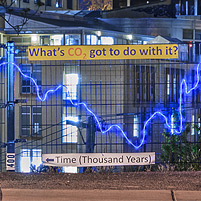The CO2 Fence

One of Carnegie Mellon University's campus icons is the Fence — found in the center of the "Cut" and used as a billboard for student groups.
CMU now has another fence that's getting some attention. This one spans a stretch of real estate along Oakland's Forbes Avenue and has recently been transformed into a timeline going back hundreds of thousands of years into Earth's past.
Sculpted by chemistry graduate student Longzhu Shen (MCS'12), the latest installation at CMU's ArtPark Lab uses environmentally-friendly lighting to illustrate the fluctuation of carbon dioxide levels in Earth's atmosphere over the past 800,000 years.
Shen hopes that it draws attention to the unprecedented rise in carbon dioxide levels since the Industrial Revolution and stimulates public discussion about sustainability.
"If you look back over 800,000 years, the carbon dioxide level fluctuated between 172 and 292 parts per million (ppm). It never passed 300ppm," Shen said. "But the current level is about 393ppm. That is really, really striking evidence for people to consider how our behavior can impact nature and what changes need to be made toward a sustainable future."
The art installation — What's CO2 Got To Do With It? — comprises six 33-feet-long solar-powered LED ropes that glow a brilliant blue at nighttime. Shen and his artwork faculty sponsor, CMU Research Professor of Chemistry Mark Bier, came up with the idea.
Shen downloaded the CO2 data gathered from ice cores in Antarctica and used the computer program Mathematica to scale the data to fit the fence. Each dip and climb in carbon dioxide concentration is as scientifically accurate as he could meticulously fasten the LED rope using nearly 500 tie wraps.
"What makes this work special is the integration of art and science. The aesthetics of art makes the scientific information fun to look at," said Shen, who studies under the direction of Teresa Heinz Professor of Green Chemistry Terry Collins.
Shen's work is just one example of CMU's longstanding commitment to the environment and a sustainable energy future.
"We wanted to get people to think about this topic through art," Bier said. "Almost every night when I walk by I see people stopping and looking at it."
Natasha Kholgade (CS'12) did just that on a warm evening in late April.
"I saw the timeline and then I looked all the way to the right and saw this big jump," said Kholgade. "Every day people buy new cars and they don't think about how it is affecting the atmosphere. I think this [artwork] is a good statement to provoke emotions from people."
Related Links: Read more | Environment at CMU | Energy at CMU | Mellon College of Science | ArtPark | Promising Future
